
The architecture of cathedrals and great churches is characterised by the buildings' large scale and follows one of several branching traditions of form, function and style that derive ultimately from the Early Christian architectural traditions established in Late Antiquity during the Christianization of the Roman Empire.
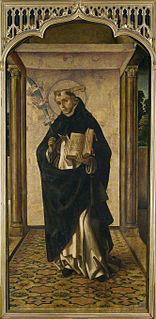
Peter of Verona, also known as Saint Peter Martyr and Saint Peter of Verona, was a 13th-century Italian Catholic priest. He was a Dominican friar and a celebrated preacher. He served as Inquisitor in Lombardy, was killed by an assassin, and was canonized as a Catholic saint 11 months after his death, making this the fastest canonization in history.
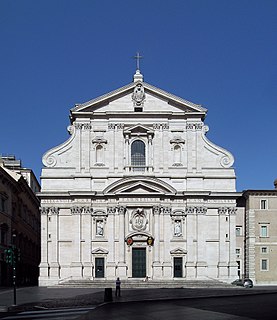
The Church of the Gesù is the mother church of the Society of Jesus (Jesuits), a Catholic religious order. Officially named Chiesa del Santissimo Nome di Gesù all'Argentina, its facade is "the first truly baroque façade", introducing the baroque style into architecture. The church served as model for innumerable Jesuit churches all over the world, especially in the Americas. Its paintings in the nave, crossing, and side chapels became models for Jesuit churches throughout Italy and Europe, as well as those of other orders. The Church of the Gesù is located in the Piazza del Gesù in Rome.
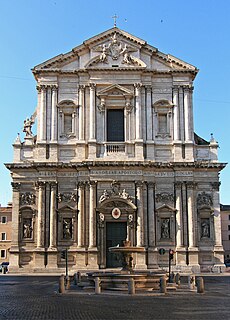
Sant'Andrea della Valle is a minor basilica in the rione of Sant'Eustachio of the city of Rome, Italy. The basilica is the general seat for the religious order of the Theatines. It is located at Piazza Vidoni, 6 at the intersection of Corso Vittorio Emanuele and Corso Rinascimento.

Vincenzo Foppa was an Italian painter from the Renaissance period. While few of his works survive, he was an esteemed and influential painter during his time and is considered the preeminent leader of the Early Lombard School. He spent his career working for the Sforza family, Dukes of Milan, in Pavia, as well as various other patrons throughout Lombardy and Liguria. He lived and worked in his native Brescia during his later years.

The Certosa di Pavia is a monastery and complex in Lombardy, northern Italy, situated near a small town of the same name in the Province of Pavia, 8 km north of Pavia. Built in 1396–1495, it was once located on the border of a large hunting park belonging to the Visconti family of Milan, of which today only scattered parts remain. It is one of the largest monasteries in Italy.

The basilica diSan Pietro is a catholic basilica and abbey in the Italian city of Perugia.

Sant'Andrea delle Fratte is a 17th-century basilica church in Rome, Italy, dedicated to St. Andrew. The Cardinal Priest of the Titulus S. Andreae Apostoli de Hortis is Ennio Antonelli.

Benedetto Briosco (c.1460–c.1517) was an Italian Renaissance sculptor and architect, active in Lombardy.

The Basilica of Sant'Eustorgio is a church in Milan in northern Italy, which is in the Basilicas Park city park. It was for many years an important stop for pilgrims on their journey to Rome or to the Holy Land, because it was said to contain the tomb of the Three Magi or Three Kings.

Sant'Onofrio al Gianicolo is a titular church in Trastevere, Rome. It is the official church of the papal order of knighthood Order of the Holy Sepulchre. A side chapel is dedicated to the Order and a former grand master, Nicola Canali is entombed there. It is dedicated to Saint Onuphrius and located on the Janiculum.
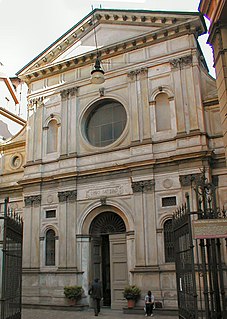
Santa Maria presso San Satiro is a church in Milan. The Italian Renaissance structure (1476-1482) houses the early medieval shrine to Satyrus, brother of Saint Ambrose. The church is known for its false apse, an early example of trompe-l'œil, attributed to Donato Bramante.

The Basilica of San Lorenzo Maggiore is a church in Milan, northern Italy. Located within the city's ring of canals, it was originally built in Roman times and subsequently rebuilt several times over a number of centuries. It is close to the mediaeval Ticino gate and is one of the oldest churches in Milan. It is near the city park called Basilicas Park, which includes both the Basilica of San Lorenzo and the Basilica of Sant'Eustorgio, as well as the Roman Colonne di San Lorenzo.

Giovanni di Balduccio was an Italian sculptor of the Medieval period.
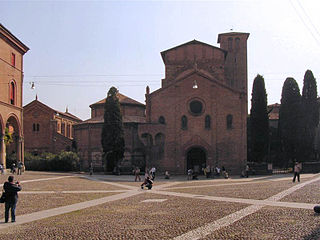
The basilica of Santo Stefano encompasses a complex of religious edifices in the city of Bologna, Italy. Located on Piazza Santo Stefano, it is locally known as Sette Chiese and Santa Gerusalemme. It has the dignity of minor basilica.

The Abbey of Santa Giustina is a 10th-century Benedictine abbey complex located in front of the Prato della Valle in central Padua, region of Veneto, Italy. Adjacent to the former monastery is the basilica church of Santa Giustina, initially built in the 6th century, but whose present form derives from a 17th-century reconstruction.
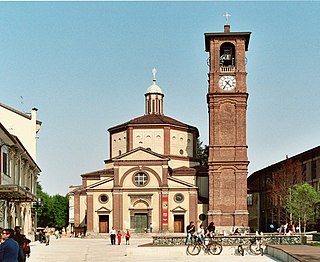
The Basilica of Saint Magnus is the principal church of the Italian town of Legnano, in the Province of Milan. It is dedicated to the Saint Magnus, who was Archbishop of Milan from 518 to 530. The church was built from 1504 to 1513 in the Renaissance-style designed by Donato Bramante. The bell tower was added between the years 1752 and 1791. On 18 March 1950, Pope Pius XII named the Basilica of San Magno a minor basilica.

The early domes of the Middle Ages, particularly in those areas recently under Byzantine control, were an extension of earlier Roman architecture. The domed church architecture of Italy from the sixth to the eighth centuries followed that of the Byzantine provinces and, although this influence diminishes under Charlemagne, it continued on in Venice, Southern Italy, and Sicily. Charlemagne's Palatine Chapel is a notable exception, being influenced by Byzantine models from Ravenna and Constantinople. The Dome of the Rock, an Umayyad Muslim religious shrine built in Jerusalem, was designed similarly to nearby Byzantine martyria and Christian churches. Domes were also built as part of Muslim palaces, throne halls, pavilions, and baths, and blended elements of both Byzantine and Persian architecture, using both pendentives and squinches. The origin of the crossed-arch dome type is debated, but the earliest known example is from the tenth century at the Great Mosque of Córdoba. In Egypt, a "keel" shaped dome profile was characteristic of Fatimid architecture. The use of squinches became widespread in the Islamic world by the tenth and eleventh centuries. Bulbous domes were used to cover large buildings in Syria after the eleventh century, following an architectural revival there, and the present shape of the Dome of the Rock's dome likely dates from this time.
Bartolomeo Caylina was a 15th-century Italian painter active mainly in Lombardy in an early-Renaissance style.




















